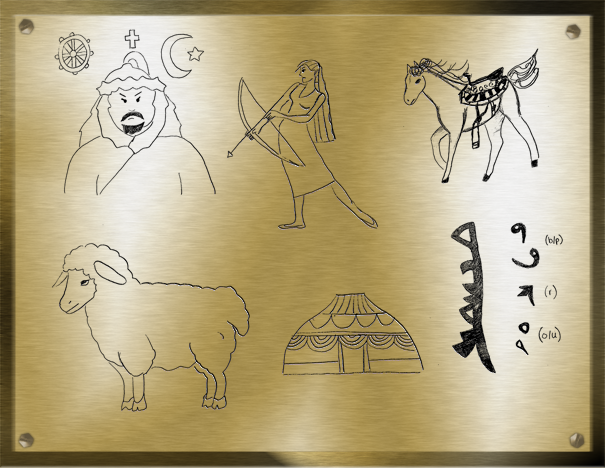| Time Period | 1206-1227 |
| Geographical Region | Mongolia, Mongolian China |
| List of Symbols |
|
This plaque embodies the early Mongol Empire, which falls in the time period under Genghis Khan’s rule, approximately from 1206-1227 A.D. The first symbol is of a Mongolian man meant to depict Genghis Khan himself. Much can be said about the Great Khan. He unified the various Turkic and Mongolic tribes into a strong confederation. He gave them the common identity as Mongol and started the military campaign that took over most of the Asian continent. [1] Above his image are three symbols: the Wheel of Dharma representing Buddhism, a cross representing Christianity, and a star and crescent symbol representing Islam. The reason these three religious symbols are placed above the Khan is because he was known for being tolerant of all religions even those he did not follow. As William of Rubruck accounted in his letter to Louis IX the French king, the Mongolian emperors were equally hospitable to all religious teachings in court, though they did not necessarily have the intention of converting to either of them. [2] Genghis Khan’s successors went on to establish their conquests in Russia, the Middle East, China and Korea, threatened Europe, and lead two expeditions to Japan (albeit failed). The second illustration is of a woman holding a bow and an arrow. This is meant to be Genghis Khan’s wife Borte, but could embody any Mongolian woman at the time. Tribesmen were obliged to join hunting and battling while women were left in charge of their flocks. However, unlike their Chinese counterparts, Mongol women were placed much higher in their society [3] and were allowed to know the battle skills of archery and how to ride horses. The horses are the third symbol in the plaque and one of the most important contributors to the successful Mongol conquest. The Mongols were expert riders and relied much on the speed that this particular breed of short-legged horses could provide. Their military tactics relied on this aspect of the horses. Each soldier was equipped with several horses and could ride for up to four days without tiring them. [4] Their brutal military tactics allowed them to establish a sufficiently terrifying reputation that made cities surrender before the Mongols even began to attack. [5] This particular drawing pertains to a horse used in battle, as can be displayed by some of its armor and saddle.
The second row of the plaque begins with a drawing of a sheep. Sheep and Goats were the main source of food and raw material for the Mongols. Their nomadic lifestyle and the steppe environment they lived in made agriculture unsuitable. The harsh winters of Mongolia allowed no access to wood or granaries. Thus, animal herding proved the most effective resource. The sheep and goats would provide meat, butter, milk and cheese. Their skin was leathered and often used as materials for their clothing and tent-like homes. [6] These homes are the next symbol. These structures are called yurts. Groups of families would travel together and in such a way form their tribe. Each yurt would contain one family. They are erected on wooden poles and are covered with skin and felt of the aforementioned animals and hand-woven with textiles in bright colors. The interior is simply furnished with bright rugs decorated with geometric patterns and animal drawings. The yurt is pitched wherever the tribe finds good pasture for their herds and is carried from place to place on horseback or on a small wagon.[7] The last symbol on the plaque is an example of the old Uyghur alphabet, which was the alphabet adopted by the Khan to give the Mongols a written version of their language.[8] This picture provides an example of some vowels in the alphabet by showing their current-day English-sounding counterparts. Thus at the time of its greatest height, the Mongol Empire extended from the Pacific Ocean to the Caspian Sea. Its importance in Chinese history relates not only to establishing the Yuan Dynasty, but also the contributions it gave to the history of the world in general.
[1] Hansen, Valerie. The Open Empire: A History of China to 1600. New York: Norton, 2000. Print. Page 313.
[2] Hansen, 318
[3] Hansen, 311
[4] Hansen, 315
[5] Hansen, 316
[6] Zhang, Elya “HIS142 Traditional China: The Mongol Empire”. University of Rochester, LeChase 141. October 8, 2015. Lecture.
[7] “Encyclopedia – Britannica Online Encyclopedia.” Encyclopedia – Britannica Online Encyclopedia. Web.
[8] Zhang

KAREN FREIRE is an International Relations major at the University of Rochester. She is from Miami, Florida. As hobbies she enjoys architecture and film. More by Karen
